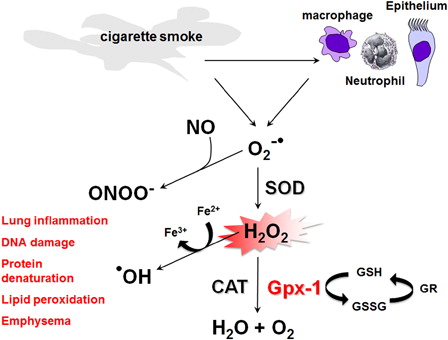Figures & data
Figure 1. Sources and production of ROS in the lung. Activation of macrophages, neutrophils, and epithelium by cigarette smoke generates superoxide radicals (O2•−) which can then either react with nitric oxide (NO) to form reactive peroxynitrite molecules (ONOO−) or alternatively be rapidly converted to damaging hydrogen peroxide (H2O2) under the influence of SOD. This in turn can result in the non-enzymatic production of damaging hydroxyl radical (•OH) from H2O2 in the presence of Fe2+. H2O2 is subsequently enzymatically reduced by glutathione peroxidases (Gpxs), including Gpx-1, as well as catalase (CAT). Gpx-1 uses GSH as a cofactor to reduce H2O2, resulting in the formation of oxidized glutathione (GSSG), which can then be reduced to GSH by glutathione reductase (GR). The ROS O2•−, ONOO−, H2O2, and •OH can then cause lung inflammation, DNA damage, protein denaturation, lipid peroxidation, and emphysema.
